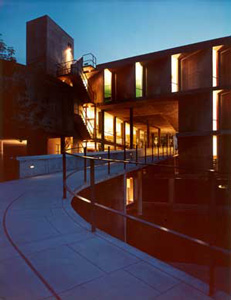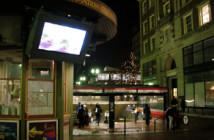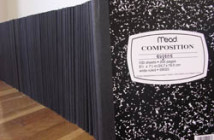Though the art department at Harvard is much-discussed, is it worth its reputation? It has that gauzy name: Visual and Environmental Studies (VES). A gossipy New Yorker article two years ago detailed the dismissal of the department chair Ellen Phelan (a painter) and the appointment of Marjorie Garber (a formidable figure in pop cultural lit crit and, gasp, not an artist at all) in her place. No MFAs are earned in VES, nor any other department at Harvard, and it seems likely that there never will be. In the highly academicized US art scene, Harvard’s failure to establish any kind of higher degree program in art practice pretty much guarantees itself a marginalized position. I could almost have written my capsule review of New VES Faculty 2004-05 exhibition without actually visiting the show. As expected, it was an assembly of work in the current currents. Where does this expectation of an unexciting mixed bag come from? Who heads to Harvard, ever, to check out an exhibit? Why is Harvard’s art department so dull?
Calvin Tomkins, the author of the New Yorker article Can Art Be Taught? How a dismissal at Harvard threw an entire field into question, suggests a direct causational relationship between the structure of the Academic Institution and the types of artwork that become au currant, “the tremendous expansion of university and college-based art departments which began soon after the Second World War has never, to my knowledge, been adequately explained…In the early forties, there were eleven institutions offering graduate degrees in studio art; today there are more than a hundred eighty.” Older, timeworn methods of passing down artistic knowledge like apprenticeships, beaux-arts academies, etc., have all been replaced by the university as a center of art practice and discourse. Tomkins quotes Harold Rosenberg, “Can there be any doubt that training in the university has contributed to the cool, impersonal wave in the art of the sixties?” (1970)
Here on the East Coast, in this city that launched a thousand colleges, we should be considering that point. It seems to me that contemporary artwork is very cool, very impersonal still, as if built to withstand a universal classroom critique. Universities are like hot houses. There are defined course objectives, timetables, assessments, GRADES. After all, there must be some kind of demonstrable product in return for the significant cash investment a course credit signifies.
Undergraduate Visual Studies majors at Harvard were asked in 2003, “How would you change visual arts training at Harvard, whether at VES or otherwise?” One response employed some surprising reasoning; “The Brown Report on the Visual Arts at Harvard emphasized the need for students to learn a visual vocabulary to complement the humanities and sciences. I think this should be fundamental to a liberal arts education; thinking creatively in the artistic sense teaches a general way of synthesizing different ideas that translates well to other fields.”
Did you catch that? An undergraduate actually justified a curricular concern with a report from the 1950’s. That report was commissioned by the University to identify and justify its own curricular concerns! The comment shows an impressive command of University administration, but such a relationship to a discipline cannot be good for undergraduate art-making...it seems bizarre and counterproductively self-conscious to consider oneself toiling away in a chosen major in order to procure a well-rounded liberal arts education. It is much more exciting, more ennobling, more dangerous, when a student is convinced that his major field of study is absolutely vital and necessary.
Is this just us? Just me? Just Harvard? Art on the West Coast has often seemed like the foil to the neurotic machinations on the East coast. When the fabled California Institute of the Arts (Cal Arts) opened in the early 1970s, its educational philosophy was based on three basic beliefs:
1. Students were to be regarded and treated as colleagues and “fully-fledged artists”
2. teaching would be tuned to the “developmental rhythm of each students,” thus entirely “noncoercive”; and
3. faculty should teach only those “subjects in which they were immediately and personally engaged." This made it easy for Cal Arts to hire the best and most radical artists of the time.
However, (as Judith Adler assessed in 1979) that same faculty quickly found themselves in a mess. At that time, there were no formal course requirements. Some teachers came to view their teaching jobs as no more than “an attractive gig, a source of easy money.” (they still often seem to, don’t they? At least the hip ones!) According to Adler, this was an untenable situation. Cal Arts soon returned to the traditional methods of teaching fundamentals. After the overhaul, the school began to turn out very strong graduates who were highly visible in the art world.
For a while, it seemed like VES was leaning the way of the early Cal Arts crew. Tomkin’s New Yorker article explained “Phelan was committed to teaching art as an ongoing experiment, and to do so by bringing in practicing artists, with all their anarchistic and disorderly attributes.” The approach was exciting, and a lot of other departments were paying attention. But those same disorderly attributes ultimately pissed off the Deans and led to divesting her of the Chairmanship… Tomkins’ article was very sympathetic to Phelan, but, seriously, giving her the boot probably made sense.
Allowing working artists to engage in tumultuous debates is an absolutely vital and necessary condition for art to work in a society. But these platforms for interaction are not best positioned in a university. In colleges, something more manageable, more meta, should be addressed instead (as in fact it already is at Harvard; the major curricular showpiece of VES is Film Studies.) Art does not thrive in an institutional structure. One example: the VES course catalog reports that the Carpenter Center gallery “hosts a variety of exhibitions supporting the curriculum of the department.” The New VES Faculty 2004-05 exhibition even labeled each piece with the course that its maker would be teaching. The basic curricular lesson there involved teaching students that they were being taught. Booooring.
Links:
Visual and Environmental Studies, Harvard University
All images are courtesy of the VES, Harvard University
Anneka Lenssen works at Harvard full-time as a department administrator and earns a master’s there at night. Anneka is a regular contributor to Big, Red & Shiny.




